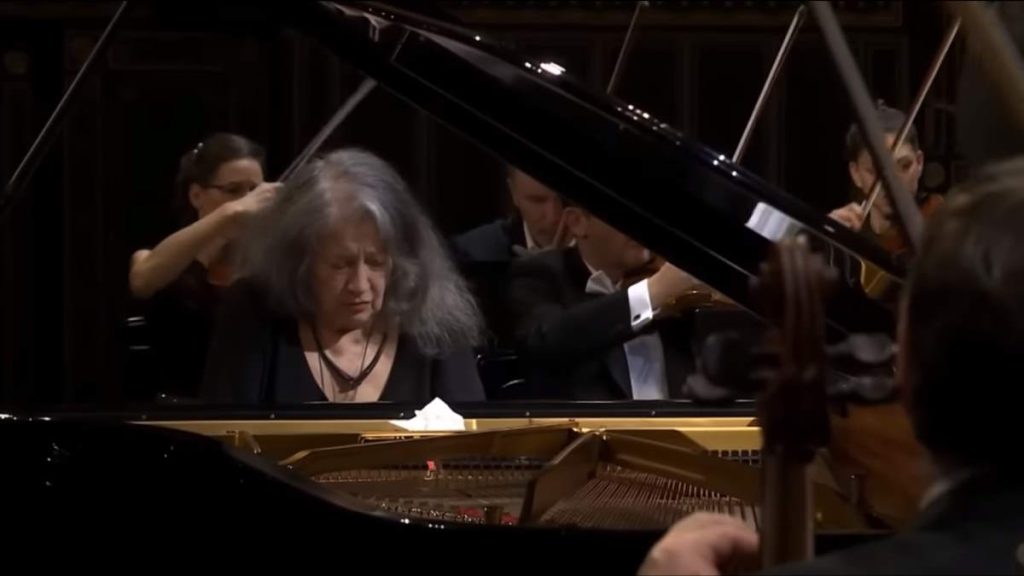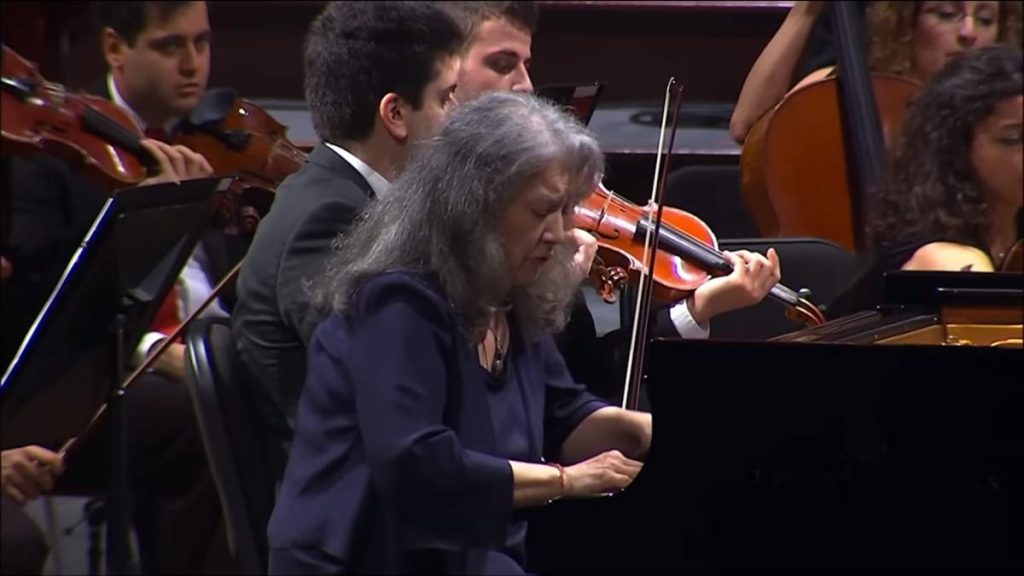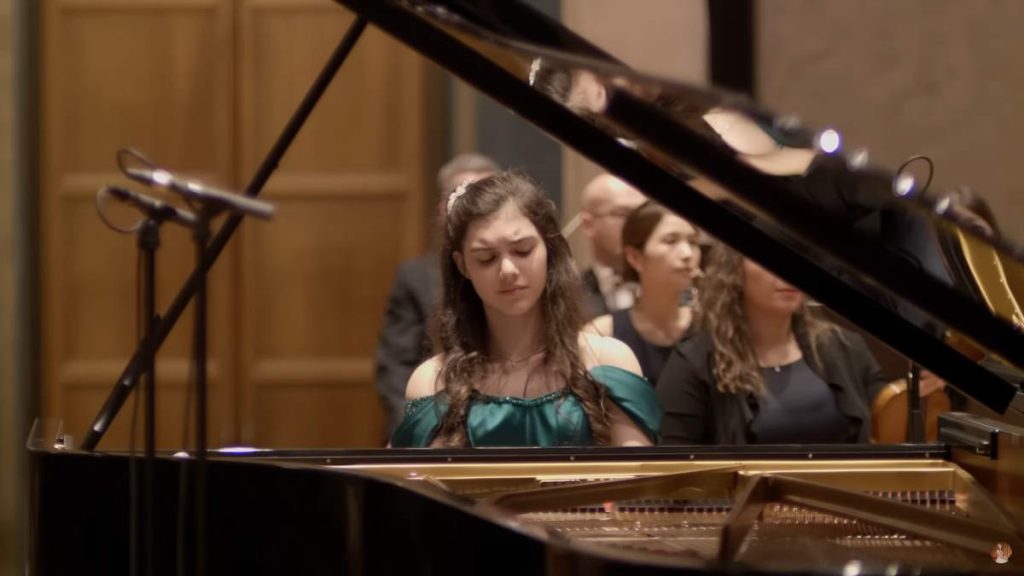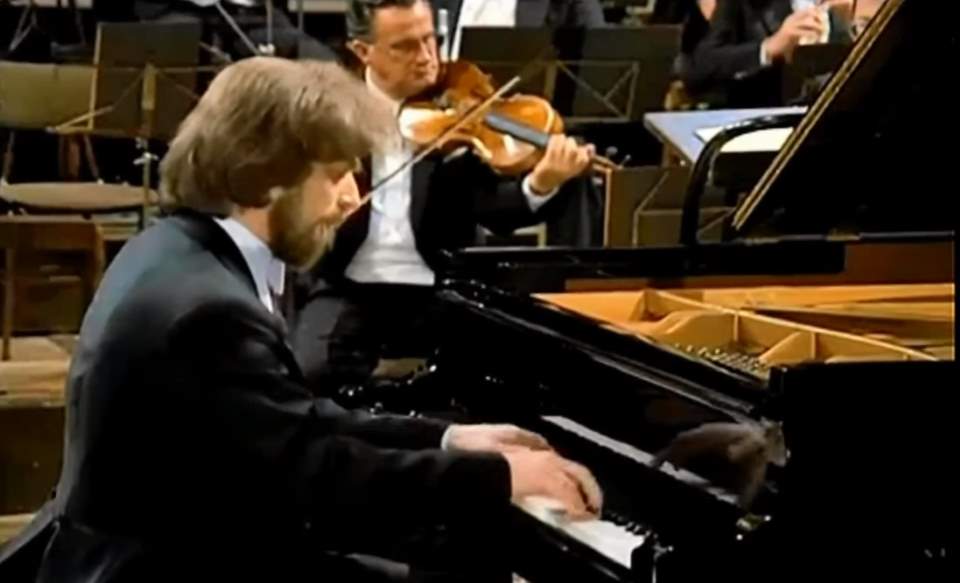Accompanied by the Academy of St Martin in the Fields, the American concert pianist and conductor Murray Perahia performs Ludwig van Beethoven’s all piano concertos (1-5). Conductor: Neville Marriner.
Program
With the starting times in the video:
- 0:00 Piano Concerto No. 1 C major, Op. 15
- Allegro con brio
- Largo
- Rondo. Allegro scherzando
- 37:44 Piano Concerto No. 2 B flat major, Op. 19
- Allegro con brio
- Adagio
- Allegro molto
- 1:06:32 Piano Concerto No. 3 C minor, Op. 37
- Allegro con brio
- Largo
- Rondo. Allegro
- 1:41:47 Piano Concerto No. 4 G major, Op. 58
- Allegro moderato
- Andante con moto
- Rondo (Vivace)
- 2:14:47 Piano Concerto No. 5 E flat major, Op. 73 “Emperor”
- Allegro in E-flat major
- Adagio un poco mosso in B major
- Rondo: Allegro ma non troppo in E-flat major
Beethoven’s Piano Concerto No. 1
Ludwig van Beethoven’s Piano Concerto No. 1 in C Major, composed between 1795 and 1801, showcases the young composer’s evolving style. Though it was published after his Piano Concerto No. 2, this concerto is recognized as his first because it was written earlier. It follows the classical tradition established by Haydn and Mozart, but with a boldness and originality that hints at Beethoven’s later, more revolutionary works.
The concerto is a delightful interplay between the piano and orchestra, reflecting Beethoven’s virtuosic skills as a pianist. The piece opens with a grand orchestral statement, followed by a lively dialogue between soloist and ensemble. The second movement provides a lyrical, introspective contrast, while the third movement concludes with a playful, exuberant finale. Beethoven’s use of dynamics, unexpected key changes, and rhythmic innovations add depth to the composition, making it a favorite among concert pianists and audiences alike.
Movements:
- Allegro con brio – A lively, bold opening, full of energy and dramatic contrasts. The soloist engages in an intense dialogue with the orchestra, combining virtuosic passages with moments of lyricism.
- Largo – A slow, lyrical movement that contrasts the first with its serene, introspective mood. The piano and orchestra weave together tender, expressive melodies, emphasizing emotion and beauty.
- Rondo. Allegro scherzando – The finale is light-hearted and playful, featuring a lively, dance-like theme. The piano leads the way with spirited runs and arpeggios, while the orchestra keeps pace with energetic rhythms.
Beethoven’s Piano Concerto No. 2
Beethoven’s Piano Concerto No. 2 in B-flat Major was actually composed before his Concerto No. 1, but published later, hence the numbering. Written between 1787 and 1795, this concerto reveals Beethoven’s early influences from Haydn and Mozart, yet it already hints at his evolving, more daring musical voice. The concerto is elegant, light, and full of charm, showcasing Beethoven’s mastery of the classical form while allowing for virtuosic piano performance.
Although less groundbreaking than his later works, Piano Concerto No. 2 is admired for its graceful melodies, refined structure, and the delightful interplay between the piano and orchestra. Beethoven performed this concerto himself at his public debut in Vienna in 1795, demonstrating his piano skills and promising career as a composer.
Movements:
- Allegro con brio – A bright and spirited opening movement, featuring graceful dialogue between piano and orchestra. The soloist plays playful yet virtuosic passages, contrasting with the refined orchestral accompaniment.
- Adagio – A calm, lyrical movement where the piano expresses delicate, poetic melodies, accompanied by a gentle orchestral backdrop. The music is serene and introspective, showing Beethoven’s sensitivity to emotion.
- Rondo. Molto allegro – A lively and energetic finale, where the piano takes the lead with spirited, dance-like themes. The movement is playful, light-hearted, and full of virtuosic flair, ending the concerto with charm and exuberance.
Beethoven’s Piano Concerto No. 3
Ludwig van Beethoven’s Piano Concerto No. 3 in C Minor, composed in 1800 and premiered in 1803, marks a significant departure from his earlier works, blending classical form with his emerging Romantic intensity. This concerto stands out for its dramatic use of the minor key, a rarity in concertos of the time, and it signals a more mature, bold Beethoven.
The concerto opens with a dark, intense orchestral introduction before the piano enters, carrying on a powerful and dramatic dialogue with the orchestra. The second movement contrasts this tension with a lyrical, introspective calm. The finale is energetic and triumphant, maintaining the intensity of the work while offering a brighter resolution. The concerto showcases Beethoven’s virtuosic piano skills and is one of his most popular concertos, reflecting his deep emotional range and technical mastery.
Movements:
- Allegro con brio – A powerful and dramatic opening, set in C minor, characterized by tension and urgency. The piano and orchestra exchange intense, virtuosic passages, creating a bold, dramatic dialogue between the two forces.
- Largo – A serene, deeply expressive movement in E major, offering a striking contrast to the first. The piano takes the lead with delicate, lyrical phrases, while the orchestra provides a gentle and atmospheric accompaniment.
- Rondo. Allegro – The finale is lively and spirited, with a playful, dance-like theme that contrasts the darker moods of the earlier movements. The piano shines with rapid, intricate passages, driving the concerto to an exuberant and triumphant conclusion.
Beethoven’s Piano Concerto No. 4
Beethoven’s Piano Concerto No. 4 in G Major, composed in 1805–1806 and premiered in 1808, is a groundbreaking work that showcases his innovative approach to the concerto form. Unlike his previous concertos, the Fourth opens with a quiet, introspective solo piano passage, rather than a full orchestral introduction, establishing a more intimate and personal dialogue between the piano and orchestra. This work is notable for its lyrical, poetic quality and subtle, dynamic contrasts.
The second movement is particularly famous for its striking contrast between the solo piano and the stern, almost foreboding strings, creating an emotional dialogue often interpreted as an allegory of Orpheus taming the Furies. The finale brings a joyful and bright conclusion, full of rhythmic vitality and Beethoven’s characteristic playfulness. This concerto remains one of the most beloved and innovative of Beethoven’s piano concertos, showcasing his deep emotional depth and technical prowess.
Movements:
- Allegro moderato – The concerto begins with an unusual solo piano entrance, setting a gentle, lyrical tone. The piano and orchestra engage in a sophisticated dialogue, with graceful and fluid melodies exchanged between the two.
- Andante con moto – This movement contrasts the lyrical piano with stern, dramatic strings. The piano’s delicate phrases, often interpreted as representing Orpheus, calm the harsh orchestral lines, creating a dynamic emotional tension that resolves into peace.
- Rondo. Vivace – A lively, joyful finale full of rhythmic energy and playful themes. The piano leads with brilliant, virtuosic passages, while the orchestra provides a vibrant, dance-like accompaniment, bringing the concerto to a bright, celebratory conclusion.
Beethoven’s Piano Concerto No. 5
Beethoven Piano Concerto No. 5 in E-flat Major, Op. 73 “Emperor”
Beethoven’s Piano Concerto No. 5, known as the “Emperor,” was composed between 1809 and 1811 and is his final piano concerto. It is one of the most grandiose and triumphant works in the piano repertoire, earning its nickname for its majestic and heroic character. The Emperor Concerto breaks from tradition by opening with the piano immediately playing a powerful cadenza-like flourish, rather than waiting for the orchestra’s introduction.
This concerto is notable for its expansive structure, bold orchestration, and the dazzling virtuosity required of the soloist. The second movement provides a serene contrast, with its lyrical, almost hymn-like beauty, while the final movement is a joyous, rhythmic Rondo that showcases Beethoven’s brilliance in bringing together innovation and tradition. The Emperor Concerto is a beloved staple of the concert hall, representing Beethoven at the height of his creative powers.
Movements:
- Allegro – The concerto begins with a powerful orchestral chord followed immediately by the piano’s bold, cadenza-like entrance. The movement is grand, heroic, and expansive, filled with energetic, virtuosic interplay between piano and orchestra.
- Adagio un poco mosso – A serene and lyrical second movement, where the piano weaves delicate, expressive melodies over a soft orchestral backdrop. The music is tender and introspective, offering a moment of calm before the final movement.
- Rondo. Allegro – The finale is lively and jubilant, featuring a playful, rhythmic theme. The piano leads with brilliant virtuosity, while the orchestra provides an energetic and dance-like accompaniment, concluding the concerto in a triumphant and joyous fashion.
Murray Perahia
Murray Perahia KBE (born April 19, 1947) is an American concert pianist and conductor. In the more than 40 years he has been performing on the concert stage, he has become one of the most sought-after and cherished pianists of our time, performing in all of the major international music centers and with every leading orchestra. He is the Principal Guest Conductor of the Academy of St. Martin in the Fields, with whom he has toured as conductor and pianist throughout the United States, Europe, Japan, and South East Asia.

Born in New York, Mr. Perahia started playing piano at the age of four and later attended Mannes College where he majored in conducting and composition. His summers were spent at the Marlboro Festival, where he collaborated with such musicians as Rudolf Serkin, Pablo Casals, and the members of the Budapest String Quartet.
He also studied at the time with Mieczyslaw Horszowski. In subsequent years, he developed a close friendship with Vladimir Horowitz, whose perspective and personality were an abiding inspiration. In 1972 Mr. Perahia won the Leeds International Piano Competition, and in 1973 he gave his first concert at the Aldeburgh Festival, where he worked closely with Benjamin Britten and Peter Pears, accompanying the latter in many lieder recitals. Mr. Perahia was co-artistic director of the Festival from 1981 to 1989.
Having completed a tour of North America with a debut recital in Mexico in the 2012-13 season, Mr. Perahia will embark on a recital tour of Japan followed by his historically first appearances in Australia where he will perform at the Sydney Opera House and in Melbourne in November 2013.
Mr. Perahia has a wide and varied discography. Sony Classical has issued a special boxed set edition of all his recordings including several DVDs entitled The First 40 Years. His recording of Brahms Händel Variations, which won the Gramophone Award in 2011, has been called “one of the most rewarding Brahms recitals currently available.”
Some of his previous solo recordings feature a 5-CD boxed set of his Chopin recordings, Bach’s Partitas Nos. 1, 5, and 6, and Beethoven’s Piano Sonatas, opp 14, 26, and 28. He is the recipient of two Grammy awards, for his recordings of Chopin’s complete Etudes and Bach’s English Suites Nos. 1, 3, and 6, and numerous Grammy nominations. Mr. Perahia has also won several Gramophone Awards.
Recently, Mr. Perahia embarked on an ambitious project to edit the complete Beethoven Sonatas for the Henle Urtext Edition. He also produced and edited numerous hours of recordings of recently discovered master classes by the legendary pianist, Alfred Cortot, which resulted in the highly acclaimed Sony CD release, “Alfred Cortot: The Master Classes.”
Mr. Perahia is an honorary fellow of the Royal College of Music and the Royal Academy of Music, and he holds honorary doctorates from Leeds University and Duke University. In 2004, he was awarded an honorary KBE by Her Majesty The Queen, in recognition of his outstanding service to music.
Sources
- Murray Perahia on Wikipedia
- Murray Perahia’s official website
- Piano Concerto No. 1 (Beethoven) on Wikipedia
- “Piano Concerto No. 1, Ludwig van Beethoven” on the L.A. Phil website
- Piano Concerto No. 2 (Beethoven) on Wikipedia
- “Concerto no. 2 for piano and orchestra (B-flat major) op. 19” on the Beethoven-haus Bonn website
- Piano Concerto No. 3 (Beethoven) on Wikipedia
- “Piano Concerto No. 3, Ludwig van Beethoven” on the L.A. Phil website
- Piano Concerto No. 4 (Beethoven) on Wikipedia
- “Beethoven’s Piano Concerto No. 4: A Masterpiece of Musical Innovation” on the L.V. Beethoven website
- “Piano Concerto No. 4, Ludwig van Beethoven” on the L.A. Phil website
- Piano Concerto No. 5 (Beethoven) on Wikipedia
- “Piano Concerto No. 5 ‘Emperor'” on the L.A. Phil website
- “Piano Concerto No. 5 in E-flat Major, Op. 73” on the Encyclopedia Britannica website




